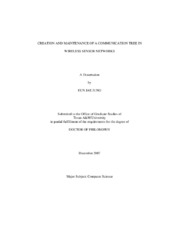Creation and maintenance of a communication tree in wireless sensor networks
Abstract
A local reconfiguration algorithm (INP) for reliable routing in wireless sensor networks that consist of many static (fixed) energy-constrained nodes is introduced in the dissertation. For routing around crash fault nodes, a communication tree structure connecting sensor nodes to the base station (sink or root) is dynamically reconfigured during information dissemination. Unlike other location based routing approaches, INP does not take any support from a high costing system that gives position information such as GPS. For reconfigurations, INP uses only local relational information in the tree structure among nearby nodes by collaboration between the nodes that does not need global maintenance, so that INP is energy efficient and it scales to large sensor networks. The performance of the algorithm is compared to the single path with repair routing scheme (SWR) that uses a global metric and the modified GRAdient broadcast scheme (GRAB-F) that uses interleaving multiple paths by computation and by simulations. The comparisons demonstrate that using local relative information is mostly enough for reconfigurations, and it consumes less energy and mostly better delivery rates than other algorithms especially in dense environments. For the control observer to know the network health status, two new diagnosis algorithms (Repre and Local) that deal with crash faults for wireless sensor networks are also introduced in the dissertation. The control observer knows not only the static faults found by periodic testing but also the dynamic faults found by a path reconfiguration algorithm like INP that is invoked from evidence during information dissemination. With based on this information, the control observer properly treats the network without lateness. Local algorithm is introduced for providing scalability to reduce communication energy consumption when the network size grows. The performance of these algorithms is computationally compared with other crash faults identification algorithm (WSNDiag). The comparisons demonstrate that maintaining the communication tree with local reconfigurations in Repre and Local needs less energy than making a tree per each diagnosis procedure in WSNDiag. They also demonstrate that providing scalability in Local needs less energy than other approaches.
Citation
Jung, Eun Jae (2007). Creation and maintenance of a communication tree in wireless sensor networks. Doctoral dissertation, Texas A&M University. Available electronically from https : / /hdl .handle .net /1969 .1 /ETD -TAMU -2038.


